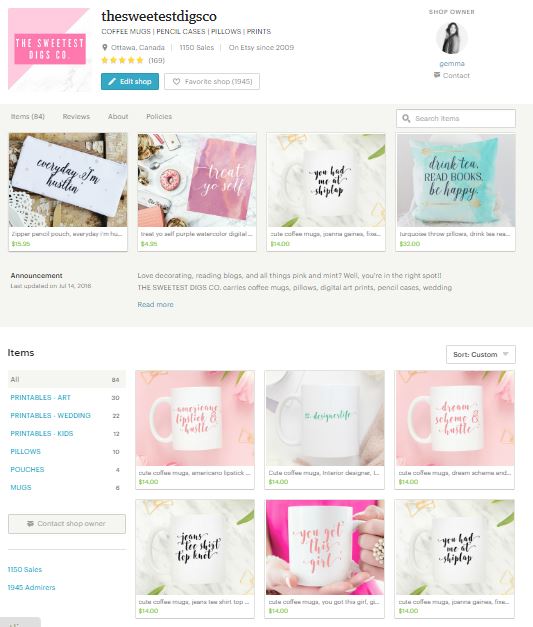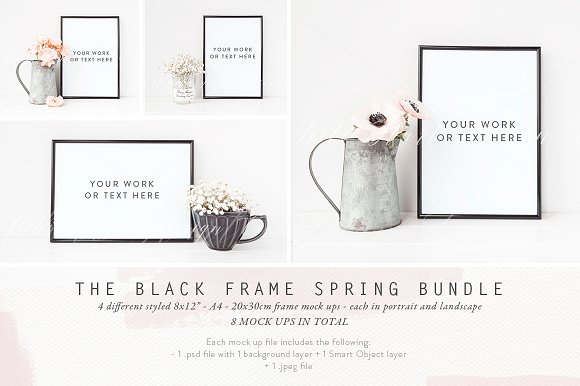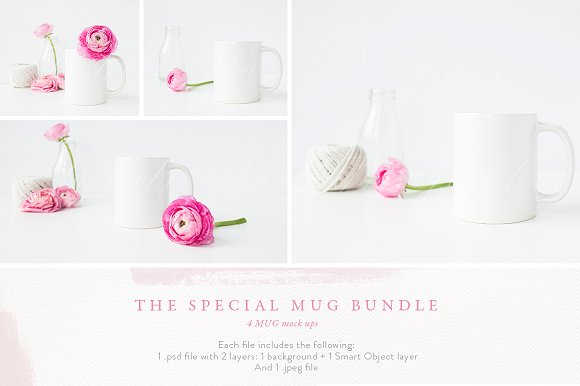Have you wondered how to create your own product line without going the handmade route?
If you have been reading this blog for a while, you’ll know I am a big promoter of diversifying your income streams as a blogger.
There are the traditional ways of monetizing – display ads, affiliate marketing, and sponsored work – but then there are some not-so-traditional avenues too.
Selling my own physical products in an online shop is one of the ways in which I have been able to dramatically increase my income. It’s a great way of expanding the potential your blogging biz.
I started off selling knit baby booties on Etsy, then moved into paintings, then art prints, and now carry pillows, pencil cases, mugs, tote bag, and more to come.

As currently a stay-at-home mama though, who still spends a lot of time on those “traditional” blogging channels, I needed the online shop to be manageable.
When I first started with the handmade items, making, packaging and shipping each one was OK. But as things grew, orders became overwhelming, I became busier with kids, and it wasn’t making sense anymore.
I thought about hiring a helper, but I wasn’t sure if that was really the best move financially or time-wise (managing a person takes time!). I also wanted to expand my line beyond things I knew how to physically make (ie. I didn’t know how to screeprint a tote bag), but I knew that I didn’t have the budget to purchase a large wholesale bulk order, or have the space to hold all that inventory.
Enter dropshipping manufacturers.
If you have a design idea and want to translate that into product, then a drop-shipping manufacturer might be just the right thing to go from concept to reality.
Basically, a dropshipping manufacturer is a company that does two things:
First, they print the product for you. So whether it’s a tee-shirt, a mug, an art print, a tea towel, whatever, they source the product and print it.
Secondly, the dropship part refers to the fact that they will ship the product directly to your customer on your behalf. This is amazing because it means you don’t have to package and ship the product yourself, and you don’t need to order and store inventory.
Before we dig in to how it works, make sure to snag my list of dropshipping manufacturers. I’m spilling the details in here on which manufacturer you might want to use, including the ones I have personally used for my own shop!

I'll send you my private list of dropshipping manufacturers straight to your email inbox. The perfect way to get starting with your new online shop!
You can also get in on my free 10-day email course that takes you through how to launch a shop. It’s packed with actionable advice!!

Here is how it works:
1 / You create your design
Maybe you are a hand-letterer who wants to translate your quotes onto products. Or maybe you are a painter. A graphic designer. A photographer. Whatever it is that you design, if it can be made into a digital graphic (ie. a PNG or JPG file), then it can be translated onto a product.
Even if you don’t have experience taking your art and making it digital, do some searching around on Google for tutorials. It’s probably easier than you think and just requires some software and know-how.
Or if you don’t have much experience in graphic design but know exactly what you’d like to create, then maybe take an online course in graphic design or watch some tutorials on YouTube. I self taught myself using videos and courses on how to use Illustrator!
The ability to take design and turn it into a product line is easier than it ever has been.
2 / Choose a dropshipping manufacturer
There are a ton of dropshipping manufacturers out there, and you might spend ages down the rabbit hole on Google checking them all out.
You should also know that not all dropshipping companies are manufacturers who print designs – some are simply companies that offer dropshipping of products (anything – tech, home decor, jewelry, etc!) that you could resell online, like through Amazon or your own website. That kind of dropshipping isn’t what I’m referring to here.
I’m referring only to companies that actually manufacture an item that has YOUR design on it. This is to create a brand new product line that has your aesthetic and your branding.
I have used several myself, researched, and talked to friends. Ultimately I have come up with a list of about 20 manufacturers who you could partner with. If you want access to that document, it’s all yours! Just enter your info below and I’ll shoot it over via email.
A word of warning: You’ll want to ask questions and be comfortable with whatever manufacturer you partner with. Find out where the items are made, how many employees they have, what their policies are, etc. I know for me that it’s important that I partner with a company that has strong ethics and fair policies.
Further, if you are going to sell on Etsy, then you need to abide by Etsy’s rules around manufacturers, and apply to have your outside manufacturer approved (you can do that here).
3 / Order samples
Once you have decided on a company to try out, upload your designs using their interface. You’ll be able to play around with placement, style, etc. and see how your design looks on the product.
I usually do a design in Adobe Illustrator (the graphic design software I use), upload it to my manufacturer’s website to see how it looks on the product mock-up, and then go back to Illustrator to make edits. I do this a few times until I get the product to look just right. Don’t rush it – make sure you take the time to ensure your design looks amazing.
Then once you’ve done that, I encourage you to order samples of the product. I have put an asterix beside the manufacturers I have personally used and can recommend in the Manufacturer’s List, but you’ll want to do quality control yourself.
Usually I’ll order samples of every product in every design and put it through testing before launching.
For example, with my mug line, I ordered the mugs and used them for my coffee every single day for months before actually launching. I wanted to make sure those bad boys held up to my dishwasher, and that I actually liked them before selling to the public.
Similarly, I’m currently putting some tee-shirts and tote bags through quality control testing right now!
Not only do you want these samples for ensuring quality, but you also need them to photograph for your shop.
4 / Photograph
Once you have developed your product line you need to actually launch it online.
There is prep work involved here: You need to photograph your products (or use a mock-up if that makes sense for what you’re selling) and write out your product descriptions.
If you aren’t adept at using your camera, either check out tutorials online or potentially hire someone to photograph your products for you. Photos are what sell products, so you want to make sure that yours are STELLAR.
Creative Market* is the best spot to find product mock-ups.
If you are looking for some mock-ups for art prints, stationery, or mugs, Lucie from White Hart Co. is one of my absolute faves. A really beautiful, minimal, style that lets the product shine. I love these simple black frames* of hers if you are selling art or photography prints…

And aren’t these bright and sweet mug mock-ups* are LOVELY?!

Remember that with any mock-ups you need to make sure the sizing is right. You can’t advertise a 14 oz mug using a mock-up showing an 11 oz, or sell an 8×10 print with a mock up meant for 5×7. See what I mean?
As for writing your product descriptions, make sure you are connecting with your potential customer. Tell them how the product will solve a problem or enhance their life in some way, and then give all of the specifics: sizing, product materials, how it’s shipped, etc. Don’t leave anything out – you want to be as upfront with the info as possible, partly just to reduce the number of customer inquiries you may receive!
4 / Launch your new shop!
There are a ton of options for actually selling online.
You can sell on your own wordpress blog by using WooCommerce.
You can use an ecommerce platform like Shopify or BigCartel.
Or you can sell on one of the big sites like Etsy, Amazon, or eBay.
I currently use Etsy and have outlined my reasons for loving their platform in this post. But choose the platform(s) that are going to be the right fit for you. There are pro’s and con’s to each.
(I’m going to test out Amazon this year and will report back on my success over there!)
6 / Sell!
Now it’s time to sell!
Unless you are a unicorn, you probably won’t make a zillion sales right away magically. You need to put in the work!
This means marketing. Figuring out how to optimize the SEO for your product listings, having amazing photos, writing blog posts that feature your products, building your email list of customers, connecting with bloggers and influencers to have them promote your product, reaching out to press and magazines for features, etc etc.
Don’t let that overwhelm you though – simply choose one or two areas to focus on first and go from there. You don’t need to do it all at once! I would recommend focusing on SEO and photos first, and then the rest over time as your shop grows in momentum.
Free Email Course
Click here to snag my totally free, 10-day email course that takes you through how to launch a shop!
Don’t forget to Pin it!

Free Resource
And if you didn’t catch it above, make sure to download my Manufacturer’s List to help you get on your way to setting up your shop. I’ve done the legwork for you – save yourself the headache!
*Affiliate links have been used. Please know I only ever recommend products and services I genuinely believe in and use myself.
–8 Bloggers who sell physical products
Original article and pictures take gemmabonhamcarter.com site
Комментариев нет:
Отправить комментарий